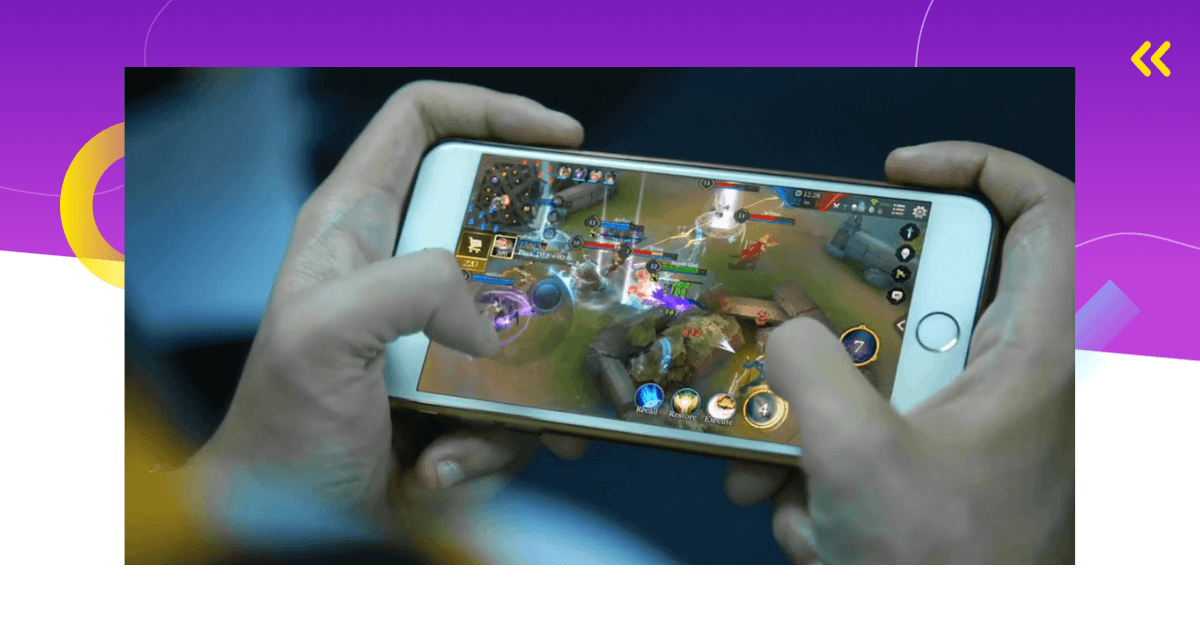A lot of people wonder what does whale mean in gaming? Why are gamers called whales? The term mobile game whales is one of those unusual terms that often confuses people in the gaming industry. However understanding the behavior of these whales is crucial for anyone involved in the industry, as they are the key players driving the in-game economy.
Here’s what you need to know about mobile game whales and how to catch them!
What Is a Whale in Gaming?
Let’s start by answering the most important question – what is a whale in gaming?
The term whale carries a significant weight in the mobile gaming industry. When we talk about a whale in gaming, we’re referring to a distinct group of players who stand apart for their spending habits. These are not your average players; a mobile game whale is someone who spends far more than the typical player, often contributing a substantial portion of a game’s revenue.
More specifically, mobile game whales can contribute an astounding 50% to 70% of a mobile game’s in-app purchase revenue, even though they represent only about 1-2% of the total player base. This disproportionate contribution underscores their importance in the mobile gaming revenue model.
What makes a whale truly unique is not just the amount they spend, but how their spending shapes the gaming landscape. Developers and publishers pay close attention to these whales, as their investment can significantly influence the financial success of a game.
So, when you hear the term mobile game whale, think of it as a metaphor for the big fish in the sea of gaming. These are the players who dive deep into their pockets, making waves in the gaming industry with their substantial spending.

How Much Do Whales Spend on Mobile Games?
Unlike regular players, video game whales spend a lot. I’m talking thousands, and in some cases, millions of dollars.
John Koetsier, VP of Singular, in an article on mobile game whales, mentioned that he spoke to a casual mobile game publisher who had a mobile game whale that spent over $1 million on her platform.
Crazy, right?
However, contrary to the belief that all mobile game whales are indiscriminate spenders, data indicates that their spending is more modest and accumulative.
The typical transaction size for mobile gaming whales (players who have spent more than $100 in mobile Free-to-Play (F2P) games) is around $20. Over half of these whale players have never made an individual transaction exceeding $50.
Interestingly, even mega mobile game whales (spending over $1,000) often do not exceed $50 in a single transaction. This points to a behavior where whales do not necessarily aim to spend large amounts in-game, but their modest spending accumulates over time.
Increase in Spending Among Mobile Game Whales
The daily Average Revenue Per Paying User (ARPPU) for the top 5% of spenders, often categorized as whales, has seen a significant increase. Over the last three years leading up to 2023, there was a growth of 20% in daily ARPPU, amounting to almost $12 per player per day. The top 5% of spenders in all game genres averaged around $66 daily.
Mobile Game Whales Spending Patterns Across Different Genres
Here are some whales statistics from GameAnalytics that show how mobile game whales spending habits vary across different genres.
- In casual games, the ARPPU for the top 5% reached $50-$60. There was a peak ARPPU close to $100 during the hyper-casual boom, but it later stabilized to around $60.
- Classic games, including titles like word puzzlers and solitaire, showed a 35% increase in daily ARPPU, reaching upwards of $60. This is attributed partly to older players with more disposable income.
- Mid-core games, which include strategy, sports, and RPG titles, had a top 5% ARPPU of between $50-$60. The quantile variance in mid-core games was less pronounced, indicating a broader conversion across player segments.
Different Types of Mobile Game Whales
Not all mobile game whales are the same. There are slow whales and fast and furious whales. The fast and furious whale can easily end the first session spending over $500, while slow whales take their time.
Slow mobile game whales are much slower in their spending habits. At first, they’ll spend only a small amount of money to try out the items or features they’ve purchased and understand the game better. Once they get to know the game and start playing it more actively, they’ll spend more and more money.
With this type of player, your focus should be on retention, keeping them happy, engaged, and interested. Slower mobile game whales might be trickier to hunt and you will have to invest more time and effort, but they will reward you in the end.
Why Are Mobile Game Whales Your Most Valuable Users?
If we look at statistics for top-grossing games, the whales represent the smallest percentage of users who are responsible for 50% or more in revenue sales of an app.
In other words, there’s a small number of mobile game whales, but they account for the majority of a game’s revenue. They will often make a difference in a game from breaking even to being profitable.
That’s what makes mobile gaming whales special, rare, and very valuable users that every mobile app or game is going after. In the early stages of the mobile gaming explosion, every publisher hunted whales. Only a tiny fraction of gamers actually paid for in-app goodies, and while non-paying players were okay for ad revenue, big spenders — the whales — drove success.
However, as you might expect, this type of player won’t be that easy to “catch”. Top-grossing companies will sometimes pay more than $500 for a “super whale” type of user. It might seem like a lot, but if that user spends thousands of dollars in-game, the investment is completely justified.

What Is Whale vs. Dolphin in Gaming?
The categorization of players based on their spending habits brings us to an intriguing comparison: whale vs. dolphin in gaming. While we’ve already dived into the concept of a mobile game whale – the big spenders in the gaming world – it’s equally important to understand the role of dolphins and minnows, and how they differ from their more extravagant counterparts.
(For a quick summary, check out the mobile game whale chart above.)
Who Are Dolphins in Gaming?
Dolphins, in the context of mobile gaming, are players who spend more than the average player but significantly less than whales.
They are the middle-tier spenders, often investing enough to enhance their gaming experience but not to the extent that it dominates the game’s revenue. In contrast to the whales, dolphins are more numerous but their individual contributions are less impactful on a game’s financial success.
The presence of dolphins in a game’s economy is crucial.
They represent a reliable and consistent source of income, often engaging with in-app purchases and premium content. Dolphins, while not as influential as whales, bring stability to the game’s revenue stream. They are the backbone of the in-app purchase ecosystem, regularly contributing but not overshadowing the whales.
Understanding the dynamics between whales and dolphins is key for mobile game developers and marketers. It allows for a more nuanced approach to monetization strategies, ensuring that the needs and spending habits of both groups are catered to.
Who Are Minnows In Gaming?
In this hierarchy, there are also minnows – the smallest spenders.
Minnows represent the largest group of players in terms of numbers but are at the lower end of the spending spectrum. These are players who spend very little, often sticking to free-to-play aspects of a game or making occasional, nominal purchases. Unlike whales or dolphins, minnows contribute a minimal amount to a game’s revenue. However, their significance in the gaming world should not be underestimated.
While individually their financial impact might seem negligible, collectively, minnows form the vast majority of the player base. They create a vibrant community and contribute to the game’s overall engagement and popularity. This mass appeal can be crucial for the social aspects of a game, such as multiplayer modes or community events, where a large and active user base enhances the experience for all players.

The Psychology Behind Mobile Game Whales
You’re probably wondering, what drives mobile game whales to spend so much.
Well, it depends on the whale.
Some are motivated by winning and beating other players. Those types of whales want to have the best weapons, items, and gear to maximize their chance of winning.
For others, it’s about showing off.
When playing with friends, many whales want to get the best cosmetic items and signal their status. Others simply get addicted and emotionally invested in a game and its characters, which makes them spend a lot of money to get the full experience.
Many of lot of us think, “I could never become a mobile gaming whale.”
But many do.
Eurogamer interviewed David Pietz, a 34-year-old Twitch streamer who has confessed that he has probably spent upwards of $20,000 on microtransactions and loot boxes in the past five years.
When asked why he chose to spend so much on a single game, he answered, “It’s a super competitive game. It was an RPG and your characters could get more powerful by getting weapons.”
Different things motivate different players – but one thing is certain, users are spending more and more money on in-app purchases.

What Is a Whale in Gacha?
The concept of a mobile game whale takes on a particularly intriguing dimension when we talk about gacha games. A gacha system, a prevalent monetization method in many games, adds a layer of excitement and unpredictability, making it a perfect playground for whale players.
But what exactly is a whale in the context of gacha gaming?
A gacha whale is a player who spends large sums of money on games featuring a gacha system. This system is akin to a virtual lottery or a blind box, where players purchase an item without knowing exactly what they will receive.
It could be something common or, with a stroke of luck, something extremely rare and coveted, often an exclusive game character. This element of surprise and the chance to obtain something unique are what make the gacha system so alluring, especially to mobile gaming whales.
The appeal of gacha games to mobile game whales is evident.
Driven by the desire to collect their favorite characters or to own super rare items, these mobile gaming whales are often willing to spend thousands of dollars. Their spending behavior is not just about the financial investment; it’s fueled by the thrill of the chase, the excitement of the unknown, and the satisfaction of acquiring rare finds.
It’s easy to see why some compare the gacha system to gambling.
The unpredictability, the element of chance, and the potential for high rewards make it a magnet for mobile gaming whales. They are drawn to the thrill of potentially unlocking something extraordinary, which keeps them engaged and spending.
In essence, a gacha whale is not just a big spender but a player who is deeply captivated by the allure of the gacha system.

What Does ‘Whale’ Mean in Genshin Impact?
When it comes to whale games and games with gacha systems, Genshin Impact is a game that stands out.
A whale in Genshin Impact refers to a player who spends a substantial amount of money on the game’s gacha system to collect rare characters, weapons, and other in-game items.
These players stand out for their willingness to invest large sums to enhance their gaming experience.
The question of what makes you a whale in Genshin Impact can be somewhat subjective, but typically, it involves spending at levels significantly higher than the average player.

How to Catch Mobile Game Whales?
Wondering how to catch a whale?
Well, attracting and retaining mobile gaming whales – the big spenders – is like finding treasure.
These mobile gaming whales are players who contribute significantly to a game’s revenue through their substantial spending habits. But how do you catch these elusive, high-value players?
Understanding the intricacies of marketing your game to appeal to this unique player base is crucial.
Market Your Game to Mobile Game Whales
To effectively market your game to mobile game whales, it’s essential to understand what drives these players.
Mobile gaming whales are often seeking more than just casual play; they are looking for depth, challenge, and exclusivity. Offering exclusive content, such as rare characters or unique in-game items, can be a huge draw. These items should not only be visually appealing but also offer tangible in-game advantages, making them must-haves for those looking to dominate the game.
Another key strategy is to create a sense of community and prestige around being a top spender.
Make It Exclusive
Features like VIP clubs or exclusive events for high spenders can foster a sense of belonging and recognition among mobile game whales. This not only incentivizes them to continue spending but also turns them into ambassadors for your game, attracting more players.
You can do this by using effective monetization messaging. For example, you can name these offers something like a “VIP Buyer Bundle”, or a “Gold Buyer Special”. These kinds of titles should make whales feel good about these offers. Consequently – they should make them spend even more.
Personalize Mobile Game Whales’ Experience
Personalization is also crucial when targeting whale players.
Tailoring in-game offers and communications based on their spending habits and preferences can make them feel valued and understood, encouraging further investment. Analytics play a significant role here, helping to understand and predict the behaviors and preferences of these players.
Who Is the Biggest Whale in Mobile Gaming?
Identifying the biggest whale in mobile gaming is a fascinating subject, often discussed and speculated upon in various gaming communities, including platforms like Reddit.
A mobile game whale is a term that brings to mind images of players spending staggering amounts of money on their favorite games, but pinning down who the biggest whale is can be elusive.
The concept of mobile game whales extends beyond just one individual. These whale players are a group, each known for their enormous financial contributions to the games they play.
If you want to learn more about mobile game whales, Reddit is a great platform that can provide insights into the whale phenomenon, where community members share stories and speculate about these top spenders.
These threads are a testament to the curiosity and intrigue surrounding whale players. They often highlight the impact these whales have on game economies and the gaming community’s perception of them.
Final Thoughts on Mobile Game Whales
Here’s the thing.
Game publishers of the modern age rely more on scalable monetization models that will bring in a penny from each sardine, not a million from one whale.
Occasional mobile gaming whale will be a great catch, but with plenty of other fish in the sea that are willing to spend money in-game, game publishers changed their monetization models.
If you can acquire 10,000 or 100,000 users, while keeping the CPI in the same range, congrats, you’ve hit the jackpot. If you want to make this a 1,000,000 new users a month, or to hunt down a $20,000 LTV whale, consider sending us a message. We’re known for our ability to hunt down whales.
EDIT: Mobile game whales. We hunt mobile game whales, not real whales.







Comments